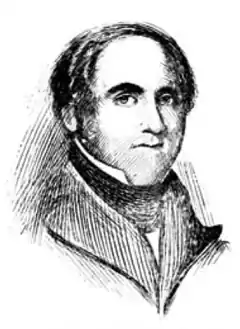Charles Morris (surveyor general)
Charles Morris (8 June 1711 – buried 4 November 1781) army officer, served on the Nova Scotia Council, Chief Justice of the Nova Scotia Supreme Court (1776–1778) and, the surveyor general for over 32 years, he created some of the first British maps of Canada's maritime region and designed the layout of Halifax, Lunenburg, Lawrencetown, and Liverpool.[3] In Halifax he laid out both the present-day down town core and the Halifax Common.
Charles Morris | |
|---|---|
 Charles Morris in Regency Era attire[1] | |
| Surveyor General | |
| In office 1748–1781 | |
| Monarch | George III |
| Succeeded by | Charles Morris (1731–1802) |
| Chief Justice of the Nova Scotia Supreme Court | |
| In office 1776–1778 | |
| Preceded by | Jonathan Belcher (jurist) |
| Succeeded by | Bryan Finucane |
| Personal details | |
| Born | 8 June 1711 Boston, Massachusetts |
| Died | 4 November 1781 (aged 70) Windsor, Nova Scotia |
| Relations | Charles Morris (1731–1802), son; Charles Morris (1759–1831), grandson |


History
He was born in Boston and when he first came to the colony he fought in the Battle of Grand Pre. The maps he produced and information he gathered about the disposition of Acadians villages during his surveying of the colony was later used by the Military authority in Halifax to initiate the Expulsion of the Acadians during the French and Indian War.
He fought for and won the establishment of the Nova Scotia House of Assembly (1758). Morris was instrumental in establishing New England Planters in the colony.
As chief justice, his most famous trial was of those who participated in the Eddy Rebellion (1776) at the outbreak of the American Revolution.
Publications


- "Judge Morris’ remarks concerning the removal of the Acadians," N.S. Hist. Soc., Coll., II (1881), 158–60
- "Observations and remarks on the survey made by order of His Excellency according to the instructions of the 26th June last, on the eastern coasts of Nova Scotia and the western parts of the island of Cape Breton," PANS Report (Halifax), 1964, app.B, 20–28;
- "The St. John River: description of the harbour and river of St. John's in Nova Scotia, and of the townships of Sunbury, Burton, Gage, and Conway, lying on said river . . . dated 25th Jan. 1768," Acadiensis (Saint John, N.B.), III (1903), 120–28.
- His joint report with Richard Bulkeley, "State and condition of the province of Nova Scotia together with some observations &c, 29th October 1763," is in PANS Report, 1933, app.B, 21–27. p.r.b.]
Legacy
- namesake of Morris Street, Halifax
- namesake of Fort Morris (Nova Scotia)
- Morris House (Halifax) which his son purchased and where he lived is the oldest wooden residence in Halifax
References
Endnotes
- This image is not contemporaneous. Given the era of the clothing, the clothing may be simply a mistake by the artist or the image is actually of Charles Morris III, who lived during the Regency Era.
- "snapd Halifax - Community Events Media". halifax.snapd.com.
- Morris was preceded in his mapping by Nathaniel Blackmore's work of 1711 & 1712, published by Herman Moll, Geographer, of London. Morris may have been the first observer/surveyor to produce and publish his own maps of the region. Like Blackmore, Morris surveyed portions of the region and then combined his work with information from other mapmakers' maps to produce his larger regional maps.
Texts
- Ethel Crathorne, "The Morris family – surveyors-general," Nova Scotia Hist. Quarterly (Halifax), 6 (1976), 207–16.
- A. W. H. Eaton, "Eminent Nova Scotians of New England birth, number one: Capt. the Hon. Charles Morris, M.C.," New England Hist. and Geneal. Register, LXVII (1913), 287–90.
- Blakeley, Phyllis R. (1979). "Morris, Charles (1711-81)". In Halpenny, Francess G (ed.). Dictionary of Canadian Biography. IV (1771–1800) (online ed.). University of Toronto Press.